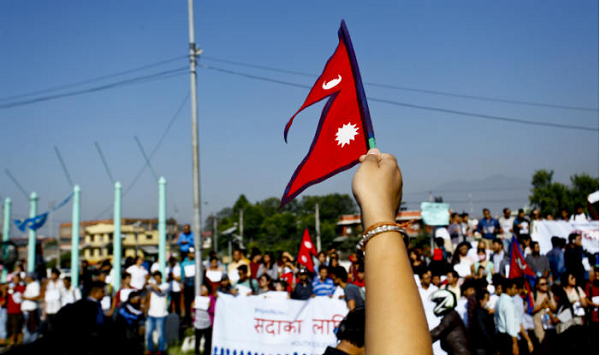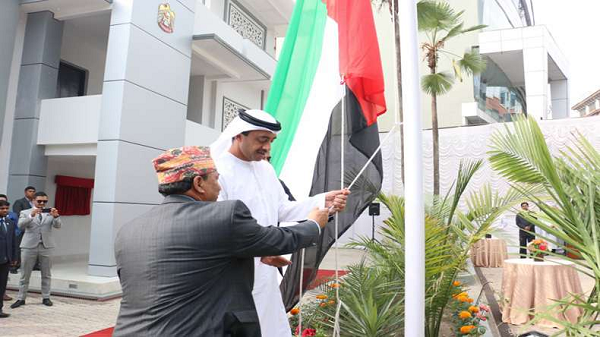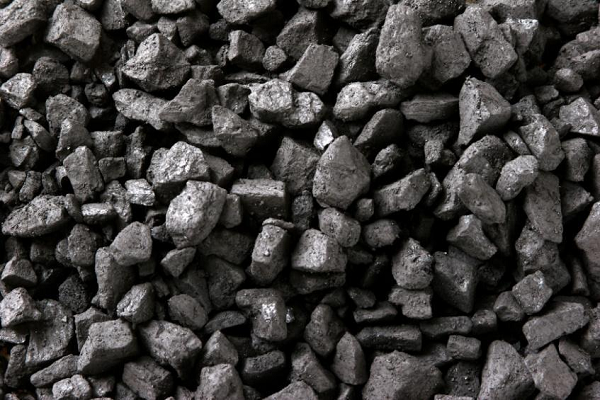
by Editor | May 25, 2021 | World
 Kathmandu, Nepal : The United States has approved a 500-million-U.S. dollar assistance to Nepal, under its Millennium Challenge Corporation (MCC) Compact programme, the MCC board announced on Friday.
Kathmandu, Nepal : The United States has approved a 500-million-U.S. dollar assistance to Nepal, under its Millennium Challenge Corporation (MCC) Compact programme, the MCC board announced on Friday.
The MCC is an independent U.S. aid agency, created in 2004, which provides time-limited grants and assistance, to poor countries, based on standards for “good governance, from fighting corruption to respecting democratic rights.”
According to a press release, issued by the MCC, dated on Thursday, Nepal is the first country to receive the aid under the MCC compact programme in South Asia.
The latest development came, two weeks after Nepal’s cabinet endorsed the ministry of finance’s proposal, to accept the grant assistance from the U.S. agency.
—NNN-NEPALNEWS

by Editor | May 25, 2021 | Economy, News, World
 Kathmandu, (IANS) Nepalese government on Saturday unveiled a record-breaking annual budget of nearly $10 billion for the next fiscal 2016-17 year.
Kathmandu, (IANS) Nepalese government on Saturday unveiled a record-breaking annual budget of nearly $10 billion for the next fiscal 2016-17 year.
Finance Minister Bishnu Poudel presented the budget of 1,048 billion Nepalese rupees (about $10 billion) for the next fiscal year with emphasis on post-earthquake reconstruction, infrastructure, and social security and enhancing connectivity with both China and India, Xinhua news agency reported.
The size of the budget has been increased 28 percent compared to last year’s $7.6 billion.
As agitating Madhesi political parties did not participate during budget presentation at the parliament, it is expected to pose challenge to implementation of budget as political instability has remained as one of the factors for poor budget implementation in the recent years.
However, the budget has introduced many programs that are focused on southern Tarai where agitating parties are based. The budget has been allocated for border area development program focused on 20 districts of southern Tarai and Postal. Roads connecting many districts of Tarai have been allocated significant budget.
With expectation that the post-earthquake reconstruction works would speed up in the next fiscal year, the budget for the reconstruction has been increased by 53 percent to 140 billion rupees.
As Nepal aims to become bridge between India and China, the budget has given high emphasis to develop roads connecting India and China border.
As the country went through difficult period when prolonged blockade was imposed in southern border points recently, creating shortage of fuel and other essentials, the new budget announced constructing storage tanks to sustain the fuel demands for at least 90 days. Currently, Nepal’s fuel storage capacity is just for 17 days.

by Editor | May 25, 2021 | World
 Kathmandu (IANS) A residential embassy of the United Arab Emirates (UAE) has been officially inaugurated in Nepal.
Kathmandu (IANS) A residential embassy of the United Arab Emirates (UAE) has been officially inaugurated in Nepal.
The Minister for Foreign Affairs of the UAE, Sheikh Abdullah Bin Zayed Al Nahyan and his Nepalese counterpart Kamal Thapa jointly inaugurated the embassy on Tuesday in Kathmandu’s Lazimpat area, Xinhua news agency reported.
“Today is a historic day in Nepal-UAE relationship with the establishment of the UAE embassy in Nepal. It is my pleasure to say that we have been enjoying a cordial and trouble-free relationship since the establishment of diplomatic ties,” the Nepalese foreign minister said.
He thanked the UAE government for dispatching the rescue and relief teams in the aftermath of the devastating April 2015 earthquake that killed nearly 10,000 people leaving 23,000 injured.
Sheikh Abdullah said that the bilateral relationship will be further enhanced with the establishment of UAE embassy in Nepal.
The UAE delegation headed by the foreign minister also held talks with Nepalese President Bidya Devi Bhandari and Prime Minister K.P Sharma Oli.
Nepal has maintained its residential embassy in Abu Dhabi since April 2004. The two countries established their diplomatic relations on January 22, 1977.
UAE has remained one of the attractive destinations for Nepalese migrant workers over the years. About 200,000 Nepalese are currently working in UAE, according to the Nepalese foreign affairs ministry.

by Editor | May 25, 2021 | World
 Kathmandu (IANS) A team of Chinese experts on Sunday launched a study on prospects for minerals, gas and oil at Shreesthan in Dailekh, a western district of Nepal, which, officials claim, holds petroleum products in abundance.
Kathmandu (IANS) A team of Chinese experts on Sunday launched a study on prospects for minerals, gas and oil at Shreesthan in Dailekh, a western district of Nepal, which, officials claim, holds petroleum products in abundance.
It is after a gap of two decades that the Nepal government has allowed Chinese geologists to begin hydrocarbon exploration in the western part of the country in a bid to become self-reliant.
Six Chinese experts are involved in the exploration bid, according to a government statement issued here.
The Chinese team will carry out the feasibility study on all 10 petroleum blocks in Nepal sprawled from east to west.
The Chinese team will report its findings in about a month on the exploration prospects apart from the amount of petroleum products that could be harnessed in the district.
The study comes in the wake of an agreement between Nepal and China during Prime Minister K.P. Sharma Oli’s visit to the communist country in March, said Minister for Industry Som Prasad Pandey, who kick-started the exploration venture.
Under the agreement, China was also to help in the construction of at least three petroleum reservoirs in Nepal.
China will also extend technical and financial help to Nepal in exploration.
Nepal began exploring for hydrocarbons some three decade ago and awarded several contracts to international firms. But the attempts were not a success due to lack of political will and adequate budget.

by Editor | May 25, 2021 | Economy, News
 By Anil Giri
By Anil Giri
Kathmandu : (IANS) With the signing of the Transit and Transportation Agreement between Nepal and China in Beijing, there is a sense of anxiety, worry and concern in Indian strategic circles about Nepal tilting towards China. Many have commented that this has ended India’s long monopoly in Nepal in doing third country business through Indian ports and, overnight, Nepal will do business, import fuel from China and so on.
As a landlocked country, seeking transit rights is Nepal’s fundamental right and, as of now, India and Bangladesh have provided such facilities to Nepal.
Realizing that Nepal will turn to China for transit and trade rights, India, during the visit of Nepalese Prime Minister K.P. Sharma Oli last month, had agreed to provide Visakhapatnam port for Nepal’s use. As of now, Nepal is using only Haldia in Kolkata for third-country trade but it is smaller than Visakhapatnam. During the visit, India also allowed Nepal land transit via Bangladesh, implicit being that India was already aware that Nepal would turn to China.
It is being said that had India allowed Nepal this when it was proposed over a decade ago, Nepal would not have gone with China. Second, if India had not imposed an unofficial blockade, privileging one community and group’s demand, Nepal would not have tilted towards China.
After signing the Transit Agreement with China, it is widely anticipated that Nepal will do business through Chinese ports and end its dependency on India. Such interpretations, particularly in Indian strategic circles, are beyond the ground realities and one should understand that a transit treaty does not necessarily measure up to implementation.
The poor infrastructure on the Nepali side, difficult geographical terrain on both sides and without a rail link up to the Nepali border in Kerung (Gyirong in Chinese side), Nepal cannot immediately begin third country business through Chinese ports. Physical infrastructure in either side of the border is important for full use of transit rights and, on the Nepali side, it will take years to upgrade Kerung, the only transit, transportation and trade route between Nepal and China.
Second, the nearest Chinese port is Tainjin which is 3,000 km from the Nepali border and the nearest Indian port is Haldia which is just 1,000 km away. This per se makes a huge difference in doing business in terms of costs, said Nepal’s former commerce secretary Purusottam Oja.
If Nepal needs to do business through Tainjin port to Kerung, it is almost impossible to import goods via trucks or containers. The only option is by rail and Chinese officials say this will happen only by 2020.
“Of course, a further extension from Gyirong is an even longer-term plan. It’s up to geographic and technical conditions and financing ability. We believe that far in the future the two countries will be connected by rail,” Hou Yanqi, deputy head of the Chinese foreign ministry’s Asia division, said in Beijing after the meeting between Oli and Premier Li Keqiang.
“Strategically it is going to be a good deal but due to distance per se, it is going to be a very costly affair for us until there is rail service from Tainjin to the Nepal border,” said Oja. “It also depends on status of infrastructure in both sides…and paper work. Hassle free paperwork for customs and other purposes are key in transit rights,” said Oja.
Another Nepal-China trading point, Tatopani, is shut down since the April 25, 2015 earthquake and there is no official confirmation whether the Chinese side will open it up or not. In case China opens it, Nepali traders have to use trucks, containers and other light vehicles to import and export goods from Tianjin, again very costly for traders.
“I am not going to use and do business through Tanjian that is going to be three-fold expensive for us,” said Indian trader Ravi Singh, who is engaged in third-country business.
“Without stressing on connectivity, the transit agreement will not be productive,” said noted economist Bishamber Pyakurel.
“Neither it is a historic pact nor is it a non-workable one. Though it is a welcome move, its success lies in implementation,” he said in an interaction with journalists.
It should also be remembered that Nepal is doing business with India through 24 small and big trading points whereas Nepal is doing business with China only through one trading point.
Then, India has also proposed to build five rail corridors with Nepal and one is proposed to connect Uttar Pradesh and Kathmandu.
The ground realities more than make clear that the ‘China card’ remains more of an illusion but Kathmandu has finally made the strategic move that New Delhi is bound to have taken note of.
(Anil Giri can be contacted at girianil@mail.com.)

 Kathmandu, Nepal : The United States has approved a 500-million-U.S. dollar assistance to Nepal, under its Millennium Challenge Corporation (MCC) Compact programme, the MCC board announced on Friday.
Kathmandu, Nepal : The United States has approved a 500-million-U.S. dollar assistance to Nepal, under its Millennium Challenge Corporation (MCC) Compact programme, the MCC board announced on Friday.



